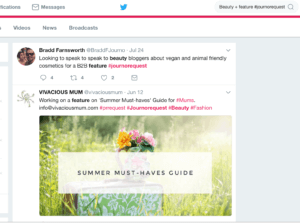How to find the perfect #journorequest
Twitter is filled with journalists seeking quotes, expert opinions and interviews for stories from across the globe. Using Twitter effectively, we have been able to secure regional, national and international news coverage for our clients on multiple occasions.
Granted, it would be impossible to tap into each and every one of these requests, but it is important to widen your search modifications to spot the best opportunities for you and your clients. By only using search terms such as #journorequest and #PRrequest, you are limiting the results you will see.

You can find relevant coverage requests using a variety of methods:
Interviews
Journalists are always on the lookout for new stories. Typically, they are working to tight deadlines, so they often use Twitter as an efficient way to find breaking stories, source expert opinions, seek answers to their questions and search for interview opportunities.
They will post a short media request which can be bombarded with replies in a matter of minutes , so time is of the essence to keep track of Twitter’s news feed and to get in touch immediately. Below is a search result using the keywords looking + for + expert + interview, which pulled up a variety of different requests from authors, journalists and news outlets seeking expert advice:

By avoiding the obvious hashtags like #journorequest and #PRrequest, you can search Twitter with real language, meaning you may find opportunities that others miss.
Other examples which may be useful include:
- Looking + for + expert + comment
- I + need + a + quote
- Can + anyone + help
- Interview + request
Promoting interview opportunities
Instead of being the one to actively seek out media requests, it it often worthwhile to try the other way around, in which case it helps to think like a journalist.
By understanding the journalist’s mindset and the way they work, you gain a better idea of how and why they are using social media. If you can tailor your campaigns to that, you can gain the interest of the media, such as:

By keeping close tabs on the news your clients’ industries fall into, you can keep your Twitter feed updated with opportunities for journalists hoping to cover the story in more detail, complete with an expert quote you have ready for them.
Searching by Twitter account
To ensure you find the most appropriate media requests for your clients, it is important to keep up to date with journalists and their whereabouts. Not only do journalists regularly move between publications, they often move desks within the brand so it is key to keep your contact list updated.
Using the search bar, add ‘journalist’, followed by your client’s niche (e.g. ‘beauty’) and then select ‘people’ from the filtering tool. You can then keep up to date with the journalists in your client’s industry by following them, engaging with them and eventually building a relationship with them.

Tailoring your journalist request
Searching for media requests on Twitter enables you to be creative and flexible with your search modifications. You can still use the hashtags #journorequest and #PRrequest, but make sure you put them after your client’s niche to really expand your search pool:
- Travel + expert #prrequest
- SMEs + comment #journorequest
- Beauty + blogger #asktwitter
- Legal + feature #mediarequest

The domino effect
It is said that 93% of organisations use Twitter for marketing, so engaging with journalists can sometimes be tricky. To engage a journalist’s interest, tweet them something authoritative and unique that only you can offer them.
An effective way of doing this is to share with them press coverage you have already gained. By doing this, you’re showing the journalist that you’re a trusted source and that your campaign is interesting and engaging enough to make regional, national or international news.

The complexities of Twitter search are considerable, but should you choose to carry out some of our recommended search requests you’ll certainly start to finding more targeted, relevant #journorequests which meet the needs and requirements of your clients.



